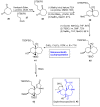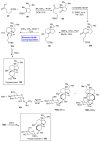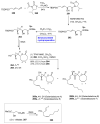Simmons-Smith Cyclopropanation: A Multifaceted Synthetic Protocol toward the Synthesis of Natural Products and Drugs: A Review
- PMID: 37570621
- PMCID: PMC10420228
- DOI: 10.3390/molecules28155651
Simmons-Smith Cyclopropanation: A Multifaceted Synthetic Protocol toward the Synthesis of Natural Products and Drugs: A Review
Abstract
Simmons-Smith cyclopropanation is a widely used reaction in organic synthesis for stereospecific conversion of alkenes into cyclopropane. The utility of this reaction can be realized by the fact that the cyclopropane motif is a privileged synthetic intermediate and a core structural unit of many biologically active natural compounds such as terpenoids, alkaloids, nucleosides, amino acids, fatty acids, polyketides and drugs. The modified form of Simmons-Smith cyclopropanation involves the employment of Et2Zn and CH2I2 (Furukawa reagent) toward the total synthesis of a variety of structurally complex natural products that possess broad range of biological activities including anticancer, antimicrobial and antiviral activities. This review aims to provide an intriguing glimpse of the Furukawa-modified Simmons-Smith cyclopropanation, within the year range of 2005 to 2022.
Keywords: Furukawa reagent; Simmons–Smith cyclopropanation; drugs; natural products.
Conflict of interest statement
The authors declare no conflict of interest.
Figures

















































Similar articles
-
Total synthesis of indoline alkaloids: A cyclopropanation strategy.Acc Chem Res. 2011 Jun 21;44(6):447-57. doi: 10.1021/ar200004w. Epub 2011 Apr 14. Acc Chem Res. 2011. PMID: 21491859
-
Efficient approaches to the stereoselective synthesis of cyclopropyl alcohols.Acc Chem Res. 2012 Sep 18;45(9):1533-47. doi: 10.1021/ar300052s. Epub 2012 Jun 22. Acc Chem Res. 2012. PMID: 22725974
-
Synthesis of amido-spiro[2.2]pentanes via Simmons-Smith cyclopropanation of allenamides.Org Biomol Chem. 2009 Aug 21;7(16):3331-7. doi: 10.1039/b908205k. Epub 2009 Jun 19. Org Biomol Chem. 2009. PMID: 19641792 Free PMC article.
-
Cyclopropanation Strategies in Recent Total Syntheses.Chem Rev. 2017 Sep 27;117(18):11651-11679. doi: 10.1021/acs.chemrev.6b00798. Epub 2017 May 3. Chem Rev. 2017. PMID: 28467054 Review.
-
[Synthetic Study of Polycyclic Natural Products Based on Development of New Strategy].Yakugaku Zasshi. 2021;141(8):985-994. doi: 10.1248/yakushi.21-00054. Yakugaku Zasshi. 2021. PMID: 34334550 Review. Japanese.
Cited by
-
Photoredox-catalyzed cyclopropanation of allenes towards vinyl-cyclopropanes.Chem Sci. 2025 Aug 14. doi: 10.1039/d5sc05057j. Online ahead of print. Chem Sci. 2025. PMID: 40852455 Free PMC article.
-
Electron donor-acceptor complex-driven photocatalyst-free synthesis of nitrocyclopropanes.RSC Adv. 2025 May 8;15(19):15155-15163. doi: 10.1039/d5ra02540k. eCollection 2025 May 6. RSC Adv. 2025. PMID: 40343315 Free PMC article.
-
Total Syntheses of Deuterated Drugs: A Comprehensive Review.Top Curr Chem (Cham). 2025 Aug 21;383(3):31. doi: 10.1007/s41061-025-00515-x. Top Curr Chem (Cham). 2025. PMID: 40839291 Review.
References
-
- Denmark S.E., Edwards J.P., Wilson S.R. Solution and solid-state structure of the “Wittig-Furukawa” cyclopropanation reagent. J. Am. Chem. Soc. 1991;113:723–725. doi: 10.1021/ja00002a078. - DOI
-
- Charette A.B., Juteau H. Design of amphoteric bifunctional ligands: Application to the enantioselective Simmons-Smith cyclopropanation of allylic alcohols. J. Am. Chem. Soc. 1994;116:2651–2652. doi: 10.1021/ja00085a068. - DOI
-
- Ukaji Y., Sada K., Inomata K. Synthesis of silicon substituted cyclopropylmethyl alcohols in optically active form via asymmetric Simmons-Smith reaction of γ-silicon substituted allylic alcohols. Chem. Lett. 1993;22:1227–1230. doi: 10.1246/cl.1993.1227. - DOI
Publication types
MeSH terms
Substances
LinkOut - more resources
Full Text Sources

